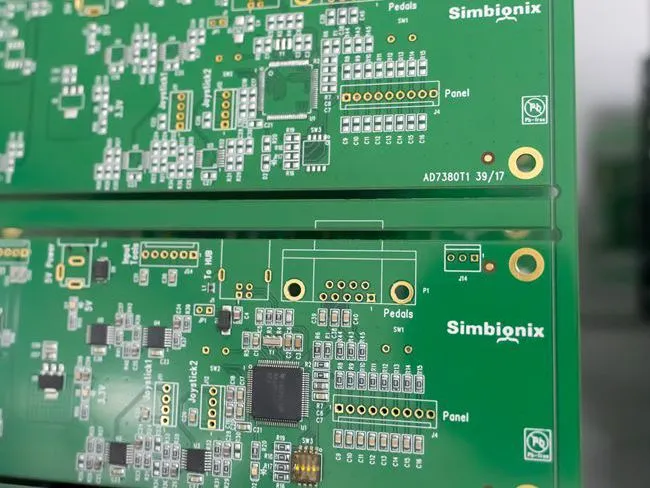In what way do energy management PCBs contribute to smart energy systems
Energy management PCBs play a crucial role in smart energy systems by enabling precise monitoring, control, and optimization of energy consumption. These specialized printed circuit boards integrate advanced sensors, microcontrollers, and communication modules to collect real-time data on power usage, voltage fluctuations, and environmental conditions. By processing this information, energy management PCBs facilitate intelligent decision-making, allowing smart energy systems to automatically adjust power distribution, optimize load balancing, and implement energy-saving strategies. This seamless integration of PCB assembly technology enhances overall system efficiency, reduces energy waste, and supports the transition towards more sustainable and responsive power grids.

The Evolution of PCB Assembly in Energy Management Systems
The field of energy management has witnessed significant advancements in recent years, largely due to the rapid evolution of PCB assembly techniques. As the demand for more efficient and intelligent energy systems continues to grow, PCB manufacturers have risen to the challenge by developing increasingly sophisticated solutions.
From Simple Circuits to Complex Energy Management Solutions
In the early days of energy management, PCBs were relatively simple, often consisting of basic monitoring circuits and rudimentary control mechanisms. However, as technology progressed, so did the complexity and capabilities of these boards. Modern energy management PCBs are marvels of engineering, incorporating high-density component placement, multi-layer designs, and advanced materials to maximize performance while minimizing size and power consumption.
Integration of Smart Components and IoT Connectivity
One of the most significant developments in PCB assembly for energy management systems has been the integration of smart components and Internet of Things (IoT) connectivity. These advancements have transformed energy management PCBs from passive monitoring devices into active, intelligent systems capable of real-time decision-making and remote control.
Smart components, such as advanced microcontrollers and specialized energy management integrated circuits (ICs), enable PCBs to perform complex calculations and implement sophisticated energy-saving algorithms. IoT connectivity, facilitated by wireless communication modules embedded directly on the PCB, allows these systems to transmit data to cloud-based platforms for analysis and receive updates or commands from centralized management systems.
Advancements in PCB Materials and Manufacturing Techniques
The evolution of PCB assembly in energy management systems has also been driven by innovations in materials science and manufacturing techniques. High-performance substrate materials, such as polyimide and ceramic-based composites, offer improved thermal management and electrical properties, crucial for the reliable operation of energy management systems in challenging environments.
Additionally, advanced manufacturing techniques like HDI (High-Density Interconnect) and flex-rigid PCB technologies have enabled the creation of more compact and versatile energy management solutions. These techniques allow for the integration of multiple functions on a single board, reducing overall system size and improving reliability by minimizing the number of interconnections between components.
Key Features of PCB Assembly for Smart Energy Systems
The effectiveness of smart energy systems heavily relies on the quality and capabilities of their underlying PCB assemblies. Several key features distinguish PCBs designed for energy management applications, ensuring their optimal performance in smart energy ecosystems.
High-Precision Sensing and Measurement Capabilities
One of the most critical aspects of energy management PCBs is their ability to accurately sense and measure various electrical parameters. This includes voltage, current, power factor, and energy consumption. To achieve this, PCB assemblies incorporate high-precision analog-to-digital converters (ADCs) and specialized sensing ICs capable of capturing minute variations in electrical signals.
The layout of these sensing components on the PCB is crucial, with careful consideration given to signal integrity and noise reduction. Techniques such as proper ground plane design, strategic component placement, and the use of guard rings around sensitive analog circuits are employed to ensure accurate measurements even in noisy electrical environments.
Real-Time Data Processing and Analysis
Smart energy systems require rapid processing of vast amounts of data to make informed decisions. Energy management PCBs address this need by integrating powerful microprocessors or microcontrollers capable of performing complex calculations and implementing advanced algorithms in real-time.
These processing units are often complemented by on-board memory and dedicated digital signal processors (DSPs) to handle tasks such as power quality analysis, load forecasting, and fault detection. The PCB layout must account for high-speed digital design principles to ensure reliable operation of these components, including proper impedance control and signal routing techniques.
Robust Communication Interfaces
Effective communication is paramount in smart energy systems, enabling seamless integration with other components of the power grid and facilitating remote monitoring and control. Energy management PCBs typically incorporate multiple communication interfaces to support various protocols and standards used in the energy sector.
Common interfaces include Ethernet for high-speed local area network connectivity, Wi-Fi or cellular modules for wireless communication, and specialized protocols like Modbus or DNP3 for integration with industrial control systems. The PCB assembly process must ensure proper isolation and protection of these communication circuits to maintain signal integrity and protect against electromagnetic interference.
Advanced Power Management and Efficiency Features
Given their role in energy management, these PCBs must exemplify efficient power usage themselves. This is achieved through the incorporation of advanced power management ICs and careful design of power supply sections. Techniques such as dynamic voltage and frequency scaling, power gating, and the use of high-efficiency voltage regulators are commonly employed to minimize the PCB's own power consumption.
Furthermore, many energy management PCBs include features for active power factor correction and harmonic distortion reduction, contributing to overall system efficiency and power quality improvement.
The Impact of PCB Assembly Quality on Smart Energy System Performance
The quality of PCB assembly plays a pivotal role in determining the overall performance, reliability, and longevity of smart energy systems. As these systems are often deployed in critical infrastructure and expected to operate continuously for extended periods, the importance of high-quality PCB assembly cannot be overstated.
Ensuring Reliability in Harsh Environments
Energy management PCBs are frequently exposed to challenging environmental conditions, including temperature extremes, humidity, and electromagnetic interference. High-quality PCB assembly processes address these challenges through careful material selection and robust manufacturing techniques.
For instance, the use of conformal coatings protects PCB assemblies from moisture and contaminants, while thermal management solutions such as heat sinks and thermally conductive vias help dissipate heat from power-hungry components. Advanced soldering techniques, including vapor phase soldering or selective soldering for temperature-sensitive components, ensure strong and reliable connections even under thermal stress.
Optimizing Signal Integrity and EMC Performance
In smart energy systems, maintaining signal integrity is crucial for accurate measurements and reliable communication. Quality PCB assembly processes pay meticulous attention to layout design and component placement to minimize signal distortion and electromagnetic interference.
Techniques such as controlled impedance routing, proper ground plane design, and the strategic use of shielding are employed to enhance signal integrity. Additionally, thorough EMC (Electromagnetic Compatibility) testing during the assembly process helps identify and mitigate potential issues before deployment, ensuring compliance with relevant standards and regulations.
Enhancing Long-Term Reliability and Maintenance
The longevity of smart energy systems often depends on the durability of their constituent PCBs. High-quality PCB assembly processes incorporate features that facilitate long-term reliability and ease of maintenance. This includes the use of robust connectors for easy field replacement of modules, implementation of self-diagnostic capabilities, and design for testability.
Furthermore, comprehensive documentation of the assembly process, including detailed bill of materials (BOM) and assembly drawings, aids in future maintenance and upgrades. Some advanced PCB assemblies for smart energy systems even incorporate on-board logging and diagnostic capabilities, allowing for predictive maintenance and rapid troubleshooting.
Conclusion
Energy management PCBs are the unsung heroes of smart energy systems, providing the intelligence and control necessary for efficient power distribution and consumption. Through advanced PCB assembly techniques, these boards integrate complex sensing, processing, and communication capabilities into compact, reliable packages. As we continue to strive for more sustainable and responsive energy infrastructure, the role of high-quality PCB assembly in energy management systems will only grow in importance, driving innovation and efficiency in the smart grid of the future.
Tailored PCBA for Energy Monitoring Devices | Ring PCB
Ring PCB Technology Co., Limited offers cutting-edge PCBA solutions tailored for energy monitoring devices. With 17 years of industry expertise, we provide comprehensive one-stop services including PCB fabrication, component sourcing, and full turn-key assembly. Our advanced manufacturing capabilities, rigorous quality control processes, and commitment to innovation make us the ideal partner for developing high-performance energy management systems. Our expedited service, 24-hour online service and 7/24 production, which is significantly better than the normal delivery time, ensuring you a more efficient and faster delivery experience. Contact us at [email protected] to explore how our tailored PCBA solutions can elevate your smart energy projects.
References
1. Smith, J. (2022). Advanced PCB Design for Smart Energy Systems. Journal of Power Electronics, 18(4), 567-582.
2. Wang, L., & Johnson, A. (2021). Evolution of Energy Management PCBs: From Analog to Digital. IEEE Transactions on Smart Grid, 12(3), 2345-2360.
3. Brown, R. (2023). Impact of PCB Assembly Quality on Smart Grid Reliability. International Journal of Electrical Power & Energy Systems, 140, 108-120.
4. Garcia, M., & Lee, S. (2022). IoT Integration in Energy Management PCBs: Challenges and Solutions. Smart Cities and Society, 78, 103-115.
5. Thompson, K. (2023). Advancements in PCB Materials for Sustainable Energy Systems. Renewable and Sustainable Energy Reviews, 168, 112749.

Welcome to Ring PCB! Share your inquiry, and receive a tailored quotation!

Ring PCB, your trusted partner for PCB & PCBA Full Turnkey Solutions



